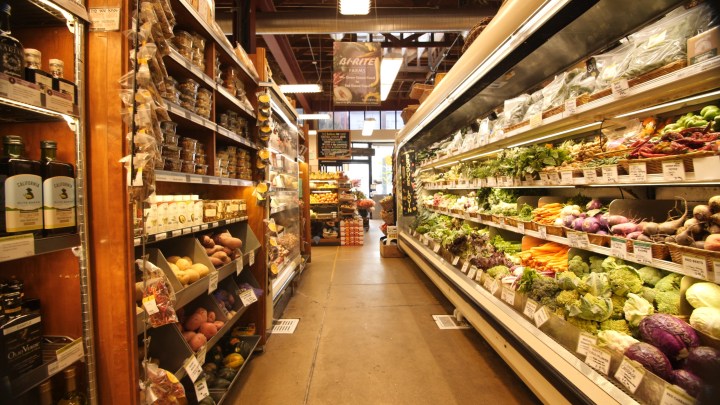
“[When you see pictures of food waste] it just blows you away,” said Stefan Kalb, a former food wholesaler. “I mean, shopping cart after shopping cart of food waste. What happens with the merchandisers when they walk through the store, and they’re pulling products that have expired, is that they’ll put it in a shopping cart and just roll it to the back. It’s almost one of those dystopian [movie] pictures … cartons of milk just piled up in a grocery cart. The ones that didn’t make it.”
If you’re an everyday consumer, the chances are that you don’t know exactly what Kalb is talking about. When you or I go to the grocery store, we do not have to walk past enormous piles of wasted food to reach the store. There aren’t huge bins at the end of every aisle filled with expired pots of hummus or salad that’s started to wilt. That would be a total downer. Based on what we see, supermarket shelves filled with a greater number of food products than ever, it’s easy to think that there isn’t a problem at all. Except that there very much is.
In the United States, somewhere between 30% and 40% of the food that’s produced is wasted. That’s the equivalent of $161 billion every single year. The U.S. throws away twice as much food as any other developed country in the world. There are all sorts of reasons this is a problem.
Part of it is the ethical issue of waste in a world where people are going hungry. Part of it is an environmental issue about the water and energy wasted producing food, and the packaging that is wasted wrapping up food that, ultimately, no-one ever eats. Could A.I. help solve the problem?
The Internet of Groceries
Kalb’s company is one of several startups — let’s call them the “Internet of Groceries” — using some impressively smart machine learning tools to help with this significant problem. Kalb is the co-founder of Shelf Engine, a company that uses analytics to help retailers better examine the historical order and sales data on their products so as to make better decisions about what to order. This means reduced waste and bigger margins. The company also buys back unsold stock, thereby guaranteeing the sale for a retailer.
“We haven’t [previously] automated this micro-decision that is happening at the grocery store with the buyer,” Kalb told Digital Trends. “The buyer of the store is predicting how much to order — [and of what]. It’s a very hard decision, and they’re doing it for hundreds and thousands of items. You have these category buyers that just walk through the store to decide how they’re gonna change their bread order or their produce order or their milk order. They’re making these micro-decisions, and it’s costing them tremendous money. If we can automate that part, then we can really make a large impact in the world.”

Big data analytics is already used in a wide range of industries, but Kalb said that food ordering is still often done using guesswork. That’s a problem because buyers may over-buy or under-buy based more on gut instinct than on hard data. For example, more than 14% of fresh juice currently spoils. More than 40% of ready-made sandwiches go to waste. Around 35% of bread remains unsold. Someone somewhere is making a mistake. This is not only wasteful, but it’s also extremely expensive for companies.
By implementing Shelf’s predictive technology, Kalb said that customers have been able to increase gross margins by 25%. Crucially, they have also been able to reduce food waste from some 30% to 16-18% simply by ordering the right quantities. When it comes to longer shelf items, this waste drops even more precipitously.
“We’re in slightly over 1,000 stores across the country,” Kalb said. “The majority of those are larger brands like Whole Foods, Kroger, and target — [although] we do have quite a few regional independents.” Over course, it’s still hoping to expand further.
Food pricing that changes based on freshness
Shelf Engine’s work goes on primarily behind the scenes. Wasteless, on the other hand, takes place in full view of the customers. Wasteless is a company that specializes in real-time dynamic pricing of food products — in a way that helps retailers, customers and, well, the environment, too.
Real-time dynamic pricing gets a bad rap. For those unfamiliar with it, it refers to the idea that the price of a product should be variable depending on the conditions. Google, for instance, has been granted a patent covering a system that would let it change the listed price of online materials, such as video and audio recordings, e-books, or games, depending on how likely a user was predicted to be in purchasing that item. It means that, in theory, a person could have the price hiked for something they really want, while another person may be offered a reduction to persuade them to buy a product they’re on the fence about. Uber, meanwhile, uses dynamic pricing (often called surge pricing) to change the cost of particular routes during times they are more heavily demanded.
Wasteless’ version of dynamic pricing is a bit different, and doesn’t come with any big downsides for consumers. It works by varying the cost of food according to how fresh it is. “Wasteless set out to develop the first real-time dynamic pricing engine for fresh food,” CEO Oded Omer told Digital Trends.
“Our A.I. for revenue optimization feeds from available expiration dates at both physical and digital retail channels, optimizing the markdowns process. Consumers interact with it to make conscious, sustainable purchasing decisions and be rewarded when picking products with a shorter expiration date over [the same product but with a longer expiration date].”
For a sense of what that means, imagine going down, say, the yogurt aisle in the grocery store. Half the yogurts expire a couple of days from now. The other half will stay fresh for two weeks. In most cases today, you’d be expected to pay the same for both. Using Wasteless’ technology, however, a store’s produce and price can be linked and then adjusted over time. Customers can be offered savings if they buy the yogurt that expires in a couple of days, although they also have the option of buying the full-priced one if they want something they can stick in the fridge and keep for longer. It’s even possible to offer additional rewards to encourage customers to buy food that would otherwise be wasted.
“With Wasteless, we are allowing families — especially low-income [families] — to easily save money,” Omer said. “We are [also] helping retailers optimize their bottom line by improving rotation, margins, and waste handling costs. And we are increasing food waste awareness right where the farm meets the fork.”
Currently, Omer said, the technology is being used “with great success” in several Western European countries, along with a demo store in New York City. “Although the awareness of the European market has started earlier, we noticed the Americans started to close the gap rapidly during 2019,” he said.
A tough problem to solve
Clever data analytics alone won’t stop food waste, of course. It’s a much bigger problem than that. But tech can certainly help make positive steps. Other companies are also tackling the problem whether it’s by engineering technologies to stop food going bad so quickly or CRISPR technologies to enhance the yield of certain crops.
This isn’t going to be solved overnight, though — and, without the right systemic and behavioral changes, no amount of venture dollars are going to be the complete answer.
But startups like Shelf Engine and Wasteless are, nonetheless, providing some invaluable solutions. And all while carving out impressive businesses for themselves and their customers. That’s what’s known as a win-win.
Editors' Recommendations
- Optical illusions could help us build the next generation of AI
- Stuck in ELO hell? HP’s A.I. coach wants to help Omen owners become better gamers
- Get ready to waste your day with this creepily accurate text-generating A.I.

